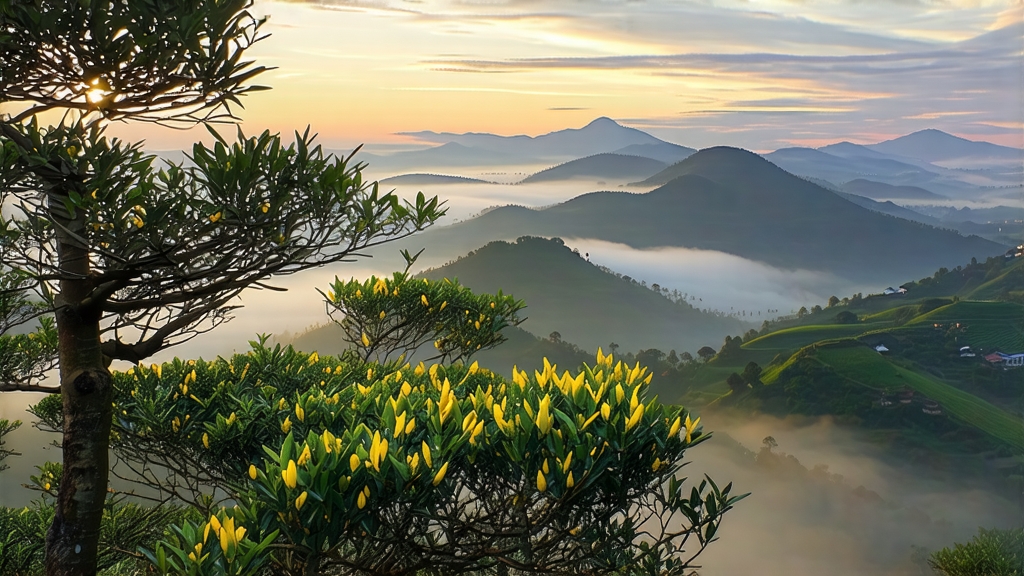
High on Meng Ding Mountain, where Sichuan’s clouds brush the shoulders of Tang-dynasty stone terraces, a tea once reserved for emperors still unfurls its single, down-covered bud each early April. Meng Ding Huang Ya—literally “Yellow Bud from the Summit of Meng”—is the least-traveled path of China’s six major tea families, a yellow tea so subtle that even seasoned drinkers confuse it with green. Yet one sip of its silky broth, the color of liquid topaz, reveals a craft that demands the patience of a watchmaker and the intuition of a poet. This article invites the international tea traveler to discover why Meng Ding Huang Ya vanished from palace records after 1911, how a handful of families resurrected its micro-fermentation, and the exact gestures needed to coax its “hidden honey” aroma from a gaiwan.
History: From Palace Tribute to Mountain Myth
The first written record appears in 825 CE when Tang poet Meng Jiao praised “the yellow shoots that grow above the clouds.” By the Song dynasty the buds were pressed into tiny cakes, stamped with the imperial dragon, and ferried down the Min River to Chengdu, then north on the post-roads to Chang’an. Ming scholars noted that the tea was “sealed three days until the leaf edges turned mustard,” an early description of the yellowing process. After the fall of the Qing, the technique survived only in the muscle memory of three hereditary tea masters who returned to monastic life, refusing to write anything down. When a 1979 agricultural survey team climbed Meng Ding, they found 87 ancient bushes guarded by monks who still measured firing time by the burning of a single sandalwood stick. Cuttings were taken, a cooperative formed, and the tribute leaf re-entered commerce in 1983—yet annual production remains below 300 kg, making it rarer per ounce than first-growth Bordeaux.
Micro-Terroir: Where Clouds Act as Greenhouse
Meng Ding summit sits at 1,450 m, a granite spine wrapped in a 90 % relative-humidity cloak 280 days a year. The classic garden, named Ganlu Si (“Sweet Dew Temple”), faces east, catching sunrise through a natural amphitheater of bamboo and wild pear. Temperature swings of 15 °C between day and night slow amino-acid metabolism, concentrating theanine at 4.2 %—almost double the level of lowland Sichuan greens. Soil is a thin acidic loam, pH 4.8, laced with quartz that reflects infrared heat back to the bushes, creating a gentle “second sunrise” effect. The result is a bud so tender that pickers wear cotton gloves to avoid bruising the trichomes whose rupture would trigger premature oxidation.
Harvest Calendar: One Dawn, One Standard
Plucking begins when the local wagtail starts its nesting call, usually between 25 March and 5 April. Only the “sparrow’s tongue” bud—12 mm long, still half-closed, bearing one unfolded leaf—is taken. A master picker can gather 600 g fresh weight in four hours, enough for 100 g finished tea. Leaves arrive at the monastery workshop within 40 minutes in bamboo baskets lined with banana leaf; any delay beyond an hour is said to flatten the mountain orchid note.
Craft: The Secret of Men Huang (Sealed Yellowing)
Yellow tea’s soul lies in a two-stage oxidation that is neither enzymatic like green nor microbial like dark tea. Step one, shaqing (“killing the green”), lasts 180 seconds on a 160 °C bamboo-roaster, hand-tossed every 4 seconds to halt polyphenol oxidase while preserving a 5 % residual moisture. The leaves are then immediately wrapped in thick yellow cotton cloth, creating a 38 °C, 85 % RH micro-oven for 48 hours. During this men huang phase chlorophyll degrades into pheophytin, catechins dimerize into theaflavins, and a faint maillard note of toasted sesame emerges. Every six hours the cloth is unrolled, the pile gently fanned, then re-wrapped; the master judges readiness by pressing a leaf between forefingers—when the vein snaps but the lamina remains elastic, yellowing is complete. A final low-temperature bake at 55 °C for three hours fixes the color and lowers moisture to 4 %, giving the finished leaf its characteristic “gold-pl